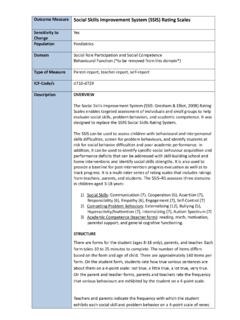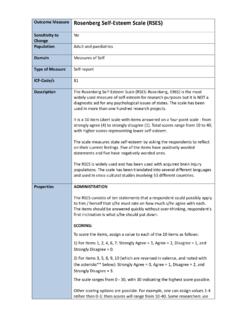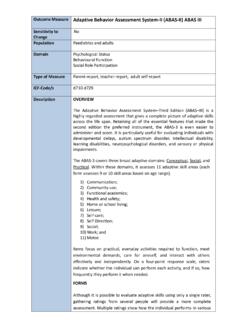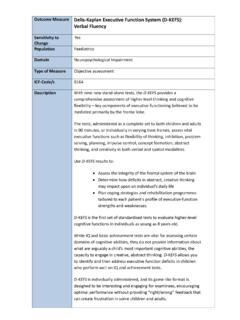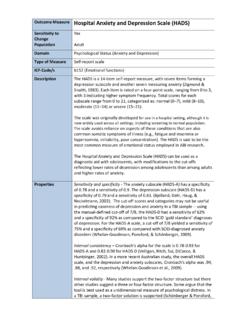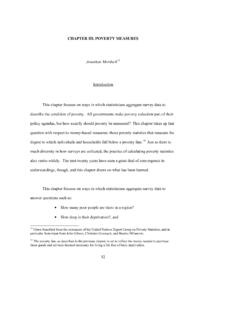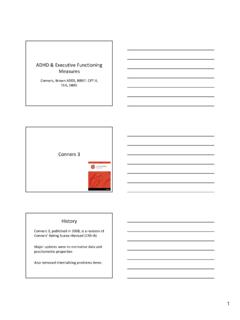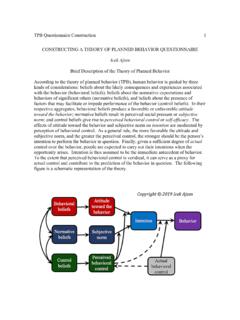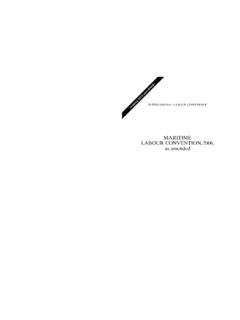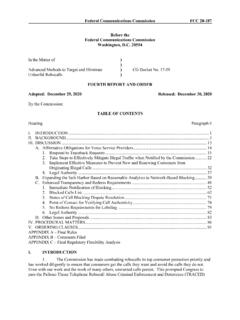Transcription of Behaviour Assessment System for Children – 3 (BASC-3)
1 Outcome measure Behaviour Assessment System for Children 3 (BASC-3) Sensitivity to Change Yes for those with severe TBI Population Paediatrics Domain Behavioural Function Type of measure Parent-report, teacher-report, clinician interview ICF-Code/s d710-d729 Description OVERVIEW The BASC-3 holds an exceptional track record for providing a complete picture of a child's Behaviour . School and clinical psychologists have depended on BASC for more than 20 years. The BASC-3 provides the most comprehensive set of rating scales. These scales measure areas important for both IDEA and DSM-5 classifications.
2 Best of all, it provides the most extensive view of adaptive and maladaptive Behaviour . The BASC-3 applies a triangulation method for gathering information. By analysing the child's Behaviour from three perspectives Self, Teacher, and Parent it offers a more complete and balanced picture. Combined, these BASC-3 tools help to understand the behaviours and emotions of Children and adolescents. FORMS 1) Self Perspective Self-Report of Personality (SRP) 2) Teacher Perspectives Teacher Rating Scales (TRS) Student Observation System (SOS) BASC-3 Portable Observation Program (POP) 3) Parent Perspectives Parent Rating Scales (PRS) Structured Developmental History (SDH) Parenting Relationship Questionnaire (PRQ) The Self-Report of Personality (SRP) provides insight into a child's or adult's thoughts and feelings.
3 Each form child (ages 8 to 11), adolescent (ages 12 to 21), college (ages 18 to 25) includes validity scales for helping judge the quality of completed forms. The SRP takes about 30 minutes to complete. The Teacher Rating Scales (TRS) measures adaptive and problem behaviours in the preschool or school setting. Teachers or other qualified observers can complete forms at three age levels preschool (ages 2 to 5), child (ages 6 to 11), and adolescent (ages 12 to 21) in about 10-20 minutes. The forms describe specific behaviours that are rated on a four-point scale of frequency, ranging from "Never" to "Almost Always.
4 " The TRS contains 105-165 items. Validity and response set indexes used to help judge the quality of completed forms are also available. The Parent Rating Scales (PRS) measures both adaptive and problem behaviours in the community and home setting. Parents or caregivers can complete forms at three age levels preschool (ages 2 to 5), child (ages 6 to 11), and adolescent (ages 12 to 21) in about 10-20 minutes. The PRS contains 139-175 items and uses a four-choice response format. All clinical and adaptive scales are listed in the chart below. Validity and response set indexes used to help judge the quality of completed forms are also available.
5 USES The BASC-3 offers a reliable, quick, and systematic way to determine behavioral and emotional strengths and weaknesses of Children and adolescents in preschool through high school. Properties Ages: 2:0 to 21:11 (TRS and PRS); 6:0 through college age (SRP) Completion Time: 10-20 minutes (TRS and PRS), 30 minutes (SRP) Scores / Interpretation: T scores and percentiles, for a general population and clinical populations Scoring Options: Q-global Web-based Administration, Scoring, and/or Reporting, or Manual Scoring. Psychometric Properties: The BASC-3 was developed preserving the psychometric properties of its predecessor.
6 The BASC-3 has been normed on a representative sample that closely matches recent Census population characteristics. T scores and percentiles are available for the general population As the BACS-3 will be released to the market in August 2015, details on psychometric properties are best refer to the manual. See Manual. Advantages 1) Assessment of a wide array of behaviours that represent both behavioural problems and strengths, including internalising problems, externalising problems, school problems, and adaptive skills. 2) Forms that can be completed in approximately five minutes or less, without the need for specialized training.
7 3) A single Total Score on the report that is a reliable and accurate predictor of a broad range of behavioural, emotional and academic problems 4) Validity indexes that identify responses that may be overly negative or inconsistent. 5) Uses a multidimensional approach for conducting a comprehensive Assessment ; 6) Strong base of theory and research gives a thorough set of highly interpretable scales; 7) Ideally suited for use in identifying Behaviour problems as required by IDEA, and for developing FBAs, BIPs, and IEPs; 8) Enhanced computer scoring and interpretation provide efficient, extensive reports.
8 And 9) Differentiates between hyperactivity and attention problems with one efficient instrument 10) Use the revolutionary, computer-based Flex Monitor to develop custom forms for data collection, scoring, and reporting. 11) Directly measure executive functioning and visual and auditory attention with the new Comprehensive Continuous Performance Test (CCPT). 12) See combined results from individual components, along with recommendations based on all information, in the new Integrated Summary Report. Disadvantages 1) Normative data based on Census population characteristics.
9 Additional Information Scoring and interpretation requires a doctorate in psychology, education, or a related field with relevant training and experience in Assessment , or a license to practice in a health or allied health care field ( doctors, nurse practitioners, social workers, etc.). Scoring can be done manually or electronically with the ASSIST/ASSIST Plus software. Administration and scoring for the TRS, PRS, and SRP should be completed by professionals or paraprofessionals that are familiar with testing procedures and with appropriate supervision.
10 As with other Level C instruments, score interpretation must be completed by professionals with formal graduate-level training or clinicians with training in psychological Assessment . The test is easy to administer, moderately easy to score, and moderately difficult to interpret based on the clinician s experience and interpretation guidelines in the manual. BASC-3 BESS Coming August, 2015 Screening System for measuring behavioural and emotional strengths and weaknesses BASC-3 Intervention Materials Coming November, 2015 Select and implement evidence-based interventions that work in schools BASC-3 Flex Monitor Coming November, 2015 Develop custom forms for data collection, scoring, and reporting BASC-3 PRQ Coming August, 2015 Designed to capture a parent's perspective on the parent-child relationship.

